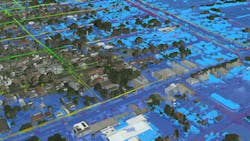Harnessing Technology to Build Back Better: A Blueprint for Resilient Energy Infrastructure
From devastating cyclones to widespread blackouts due to floods and fluctuating temperatures, extreme weather events are no longer anomalies — they are relentless. Global climate disaster costs are projected to hit $145 billion in 2025. In Australia alone, Cyclone Alfred caused $1.2 billion in damage across Queensland and New South Wales. In the U.S., Hurricane Helene inflicted more than $78.7 billion in damage in Florida. Meanwhile, in the UK, Storm Arwen, is estimated to have caused over £300 million in insurance claims.
As climate-driven disasters grow more frequent and severe, energy networks must keep systems running reliably while also upgrading infrastructure to meet modern challenges — essentially building the plane while flying it. The cost of rebuilding is ballooning, yet we’re often faced with the fraught option of restoring networks to their previous state or improving them so they are fit for purpose for a future state. Equipping industry with the solutions to meet today’s needs while evolving to the necessary future state is critical to ensure we are investing in resilient infrastructure that is prepared for the new reality of extreme weather challenges.
Rebuilding isn’t the same as improving
When poles, wires and substations are damaged, they’re often replaced like-for-like — reinstating the same vulnerable assets in the same high-risk locations. This perpetuates a costly cycle of repeated failures that we can no longer afford. While utilities and network operators understand the need to reinforce their assets, they are weighed down by the competing pressure of regulatory demands, tight budgets, and the constant urgency to restore power quickly. This leaves little opportunity to pursue more strategic, long-term solutions. Most rebuilds still rely on old data, outdated records, or engineering assumptions that no longer reflect today’s risks —an approach geared toward rapid recovery, not long-term resilience.
To break this cycle, the industry needs to deploy new solutions such as asset-centric AI that enables a consistent, more context-rich view of the network, from the individual asset level to entire integrated infrastructure networks. Physics-verified, AI-powered grid analysis can remove compromises that constrain optimised capital allocation decisions across the same asset base but through multiple, and often conflicting, subject matter lenses. This technology helps utilities align competing priorities—like vegetation risk, mechanical failure, and cost-effective restoration—into a single, ranked view that drives better outcomes and can truly build back better.
This proactive shift is essential to prevent widespread “blackout fatigue” and the understandable frustration it evokes amongst consumers. Without focusing on improving ageing energy infrastructure and modernising risk mitigation with technology, Australian consumers continue to bear the brunt of an inadequate grid.
The escalating severity and frequency of recent weather events globally have exposed how ill-equipped the current grid is to handle sustained pressures. With rising consumer demand and accelerating renewable generation, the stakes are only getting higher. Energy resilience cannot be about surviving the next storm — it must be about leapfrogging the vulnerabilities that brought us here. We cannot afford a fragile energy backbone when renewables are accelerating so quickly.
Build back better to stay ahead of risk
“Build Back Better” must evolve from a mere mantra into a global blueprint for action. This requires a fundamental shift from reactive patch-ups to proactive reinforcement, powered by technology that enables grid-strengthening without delaying consumer reconnection. The good news is we possess the tools to break the cycle. Advances in AI, digital modelling and simulation now make it possible to design, maintain and future-proof our networks in smarter, faster, more cost-effective ways. We must act decisively before the next disaster strikes.
The stakes are clear, and the evidence is compelling. Consider the 2022–2023 Murray River floods in South Australia, which left thousands without power. By leveraging Neara’s AI-powered modelling capabilities, SA Power Networks analysed 21,000 powerline spans in just fifteen minutes — a process that would have taken months with traditional methods. This efficiency helped restore power in five days instead of three weeks, providing full visibility on reusable assets. Similarly, in the US, CenterPoint Energy utilised predictive modelling ahead of a Texas winter storm to strategically position crews and significantly reduce outages, transforming a reactive scramble into a proactive deployment.
These aren’t isolated victories. Across the globe, grid operators are deploying digital models to predict vulnerabilities — where high winds could take down lines, where fires might spread, and where floodwaters could breach infrastructure. This intelligence helps them act faster, deploy resources more effectively, cut costs, and ultimately keep the lights on. True resilience stems from foresight, not just scrambling to fix what’s broken after the fact.
Let’s not waste another disaster
Every extreme weather event presents a critical opportunity to pivot — to abandon reactive responses and start building for the future. Yet, time and time again, these opportunities are being wasted. The status quo is keeping utilities stuck in a whack-a-mole pattern, chasing a long list of problems in a context vacuum when they want to be proactively solving a single, far more consequential problem — where to invest limited resources right now for maximum consumer benefit.
The good news is, we possess the technology and the data to fundamentally change this trajectory. What’s now required is the collective will from regulators, utilities, technology providers, and policymakers to align on a shared strategy for a truly resilient energy future. The cost of inaction is growing daily. Let’s not wait for another storm or extreme heat event to put a formidable plan in place to address ever-rising destruction costs. A proactive, data-driven approach grounded in asset-centric simulation modelling can be the trusted currency that aligns public and private stakeholders around prioritising projects based on hard data, not politics or emotion, offering not just long-term benefits but immediate pathways to greater stability. We have the capacity to leap forward; it is no longer a question of how, but of will.
About the Author
Jack Curtis
Jack Curtis, Neara Co-Founder and CCO
